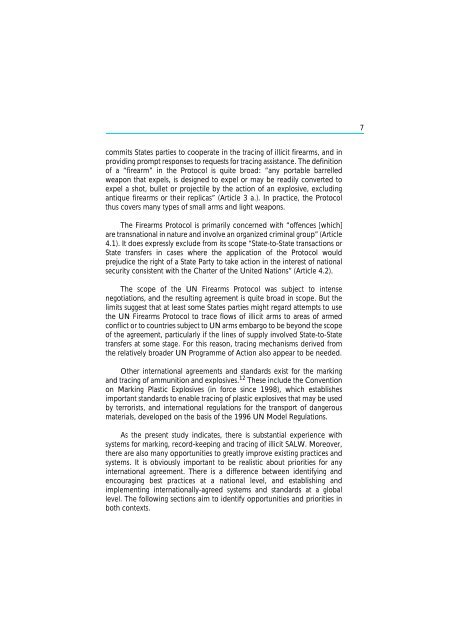The Scope and Implications of a Tracing Mechanism for Small Arms ...
The Scope and Implications of a Tracing Mechanism for Small Arms ...
The Scope and Implications of a Tracing Mechanism for Small Arms ...
Create successful ePaper yourself
Turn your PDF publications into a flip-book with our unique Google optimized e-Paper software.
7<br />
commits States parties to cooperate in the tracing <strong>of</strong> illicit firearms, <strong>and</strong> in<br />
providing prompt responses to requests <strong>for</strong> tracing assistance. <strong>The</strong> definition<br />
<strong>of</strong> a “firearm” in the Protocol is quite broad: “any portable barrelled<br />
weapon that expels, is designed to expel or may be readily converted to<br />
expel a shot, bullet or projectile by the action <strong>of</strong> an explosive, excluding<br />
antique firearms or their replicas” (Article 3 a.). In practice, the Protocol<br />
thus covers many types <strong>of</strong> small arms <strong>and</strong> light weapons.<br />
<strong>The</strong> Firearms Protocol is primarily concerned with “<strong>of</strong>fences [which]<br />
are transnational in nature <strong>and</strong> involve an organized criminal group” (Article<br />
4.1). It does expressly exclude from its scope “State-to-State transactions or<br />
State transfers in cases where the application <strong>of</strong> the Protocol would<br />
prejudice the right <strong>of</strong> a State Party to take action in the interest <strong>of</strong> national<br />
security consistent with the Charter <strong>of</strong> the United Nations” (Article 4.2).<br />
<strong>The</strong> scope <strong>of</strong> the UN Firearms Protocol was subject to intense<br />
negotiations, <strong>and</strong> the resulting agreement is quite broad in scope. But the<br />
limits suggest that at least some States parties might regard attempts to use<br />
the UN Firearms Protocol to trace flows <strong>of</strong> illicit arms to areas <strong>of</strong> armed<br />
conflict or to countries subject to UN arms embargo to be beyond the scope<br />
<strong>of</strong> the agreement, particularly if the lines <strong>of</strong> supply involved State-to-State<br />
transfers at some stage. For this reason, tracing mechanisms derived from<br />
the relatively broader UN Programme <strong>of</strong> Action also appear to be needed.<br />
Other international agreements <strong>and</strong> st<strong>and</strong>ards exist <strong>for</strong> the marking<br />
<strong>and</strong> tracing <strong>of</strong> ammunition <strong>and</strong> explosives. 12 <strong>The</strong>se include the Convention<br />
on Marking Plastic Explosives (in <strong>for</strong>ce since 1998), which establishes<br />
important st<strong>and</strong>ards to enable tracing <strong>of</strong> plastic explosives that may be used<br />
by terrorists, <strong>and</strong> international regulations <strong>for</strong> the transport <strong>of</strong> dangerous<br />
materials, developed on the basis <strong>of</strong> the 1996 UN Model Regulations.<br />
As the present study indicates, there is substantial experience with<br />
systems <strong>for</strong> marking, record-keeping <strong>and</strong> tracing <strong>of</strong> illicit SALW. Moreover,<br />
there are also many opportunities to greatly improve existing practices <strong>and</strong><br />
systems. It is obviously important to be realistic about priorities <strong>for</strong> any<br />
international agreement. <strong>The</strong>re is a difference between identifying <strong>and</strong><br />
encouraging best practices at a national level, <strong>and</strong> establishing <strong>and</strong><br />
implementing internationally-agreed systems <strong>and</strong> st<strong>and</strong>ards at a global<br />
level. <strong>The</strong> following sections aim to identify opportunities <strong>and</strong> priorities in<br />
both contexts.
















